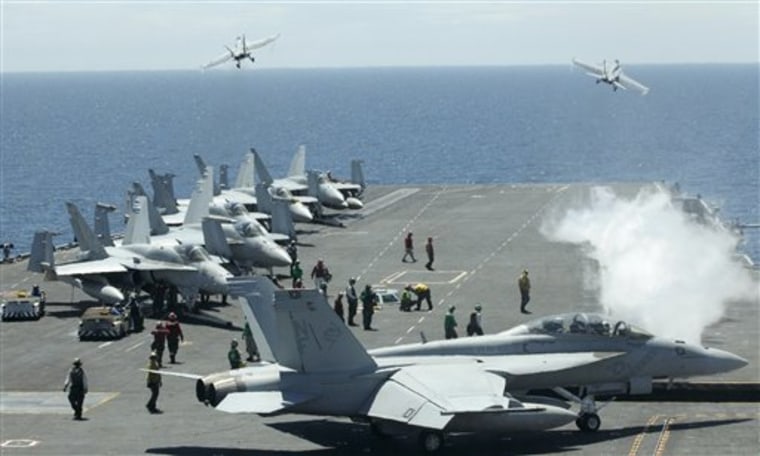The East Sea off the coast of the Korean peninsula roiled with U.S. and South Korean ships, submarines, fighter jets and helicopters — high-profile military maneuvers intended to show North Korea that it is being watched.
Military officials said that despite threats of retaliation, North Korea was staying clear. Most of the firepower for the four-day exercises — which North Korea condemns — has been flying off the decks of the USS George Washington, a U.S. supercarrier that can carry up to 70 aircraft and more than 5,000 sailors and aviators.
Washington and Seoul are hoping the drills running through Wednesday— and the deployment of the most potent symbol of the U.S. Navy's reach — will send a powerful message to North Korea in the wake of the March sinking of a South Korean warship that killed 46 sailors. An international investigation determined the ship was sunk by torpedo, likely in a sneak attack by a North Korean submarine.
"The message is in the eye of the beholder," said Rear Adm. Daniel Cloyd. "But we would hope that they would take this and messages in the future as a message of resolve. We hope this will give them pause."
North Korea — which has denied any connection to the sinking — has threatened to counter the maneuvers with some sort of military show of its own. But as the drills entered their third day Tuesday, South Korea's military said there have been no signs that the North will make good on its saber-rattling rhetoric.
Cmdr. Ray Hesser, head of an anti-submarine helicopter squadron on the George Washington, said North Korean submarines are largely restricted to shallow, coastal waters.
"We're not expecting to see them out here," he said. "I would not think they would be willing or wanting to come all the way out here."
He said the South Korean warship, the Cheonan, may have been unprepared when the attack occurred, noting that U.S. ships observe higher readiness.
"It was like a sucker punch," Hesser said. "It doesn't say much about how much of a fighter you are."
Heightened tensions
The sinking — the worst military attack on South Korea since the 1950-53 Korean War — sharply raised tension on the divided peninsula, which technically is still in a state of war because the conflict ended with an armistice, not a peace treaty. Tuesday marks the 57th anniversary of the signing of the armistice.
The "Invincible Spirit" exercises involve about 20 ships, 200 aircraft and about 8,000 U.S. and South Korean sailors. It is the Japan-based George Washington's first deployment to South Korea since 2008.
The anti-submarine phase of the training — which also involves anti-ship and anti-aircraft operations — is particularly important because it helps ready the U.S. and South Korean navies to respond to scenarios focused on North Korean submarine activities.
"I am concerned about every submarine underwater that I don't know about," Capt. David Lausman, the carrier's commanding officer, said Monday.
Lausman said the attack demonstrated the opaque nature of Pyongyang's military, which he said should not be underestimated.
"North Korea's danger lies because they are unpredictable," he said. "The sinking of the Cheonan is a prime example."
North Korea has strongly protested the exercises, saying they are a provocation, and in flourishes of rhetoric typical of the regime, it vowed to respond with a "sacred war" and a "powerful nuclear deterrence."
"Should the U.S. imperialists and (South Korea) finally ignite a new war of aggression ... (North Korea) will mobilize the tremendous military potential including its nuclear deterrence for self-defense and thus wipe out the aggressors," North Korea's defense chief, Kim Yong Chun, said in Pyongyang on Monday, according to the official Korean Central News Agency.
Kim also reiterated the country's threat to bolster its nuclear deterrent in a new, though unspecified, way to cope with what he called rising nuclear threats from the U.S.
Pyongyang issued a similar warning in June, and analysts said it likely referred to uranium-enrichment and nuclear-fusion programs the country has been trumpeting in addition to its known plutonium-based programs.
"As we've made clear, the military exercises that are under way are defensive in nature," State Department spokesman P.J. Crowley told reporters in Washington on Monday. "And what we would like to see from North Korea are fewer provocative words and more constructive actions."
___
Associated Press writer Hyung-jin Kim in Seoul contributed to this report.
